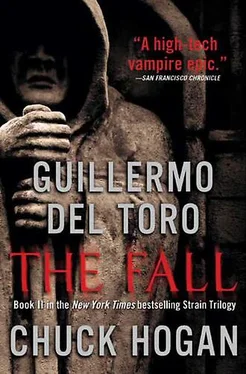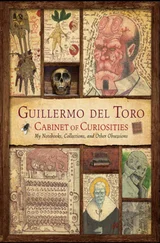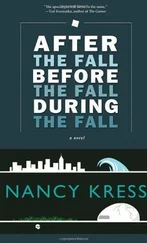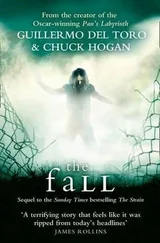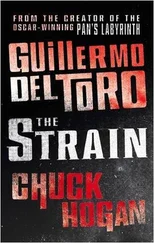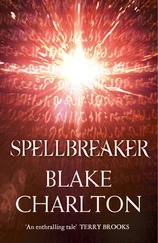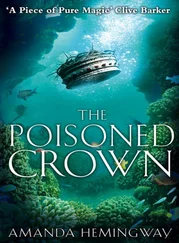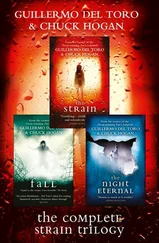The full extent of the plague was known to Setrakian, but the rest of the world resisted the horrible truth. Since then, another airplane had shut down soon after landing at London’s Heathrow Airport, stopping dead on the taxiway to the gate. At Orly Airport, an Air France jet arrived stillborn. At Narita International Airport in Tokyo. At Franz Joseph Strauss in Munich. At the famously secure Ben Gurion International in Tel Aviv, where counterterrorist commandos stormed the darkened airliner on the tarmac to find all 126 passengers dead or unresponsive. And yet no alerts were issued to search the cargo areas, or to destroy the airplanes outright. It was happening too fast, and disinformation and disbelief ruled the day.
And on it went. In Madrid. Beijing. Warsaw. Moscow. Brasilia. Auckland. Oslo. Sofia. Stockholm. Reykjavik. Jakarta. New Delhi. Certain more militant and paranoid territories had correctly initiated immediate airport quarantines, cordoning off the dead jets with military force, and yet… Setrakian couldn’t help but suspect that these landings were as much a tactical distraction as an attempt at infection. Only time would tell if he was correct — though, in truth, there was precious little time.
By now, the original strigoi — the first generation of vampires, the Regis Air victims, and their Dear Ones — had begun their second wave of maturation. They were becoming more accustomed to their environment and new bodies. Learning to adapt, to survive — to thrive. They attacked at nightfall, the news reported “rioting” in large sectors of the city, and this was partially true — looting and vandalism ran rampant in broad daylight — but no one pointed out that activity spiked at night.
Because of these disruptions occurring nationwide, the country’s infrastructure was beginning to crumble. Food delivery lines were broken, distribution delayed. As absences increased, available man-power suffered and electrical outages and brownouts went unserviced. Police and fire response times were down, and incidences of vigilantism and arson up.
Fires burned. Looters prevailed.
Setrakian stared into his face, wishing he could once again glimpse the younger man within. Perhaps even the boy. He thought of young Zachary Goodweather, just down the hall in the spare bedroom. And, somehow, the old man at the end of his life felt sorry for the boy — eleven years old but already at the end of childhood. Tumbling from grace, stalked by an undead thing occupying the body of his mother…
Setrakian stepped out to the dressing area of his bedroom, finding his way to a chair. He sat with one hand covering his face, waiting for the disorienting sensation to pass.
Great tragedy leads to feelings of isolation, which sought to envelop him now. He mourned his long-lost wife, Miriam. Memories of her face had been crowded out of his mind by the few photographs in his possession, which he referred to often and which had the effect of freezing her image in time without ever truly capturing her being. She had been the love of his life. He was a lucky man; it was a struggle sometimes to remember this. He had courted and married a beautiful woman. He had seen beauty and he had seen evil. He had witnessed the best and the worst of the previous century, and he had survived it all. Now he was witnessing the end.
He thought of Ephraim’s ex-wife, Kelly, whom Setrakian had met once in life and once again in death. He understood the man’s pain. He understood the pain of this world.
Outside, he heard another automobile crash. Gunshots in the distance, alarms ringing insistently — cars, buildings — all going unanswered. The screams that split the night were the last cries of humanity. Looters were taking not only goods and property — they were looting souls. Not taking possessions — but taking possession.
He let his hand fall, landing upon a catalog on the small side table. A Sotheby’s catalog. The auction was to be held in just a few days. This was not a coincidence. None of it was coincidence: not the recent occultation, not the conflict overseas, not the economic recession. Like orderly dominoes we fall.
He lifted the auction catalog and searched for a particular page. In it, without any accompanying illustration, was listed an ancient volume:
Occido Lumen (1667) — A compleat account of the first rise of the Strigoi and full confutation of all arguments produced against their existence, translated by the late Rabbi Avigdor Levy. Private collection. Illuminated manuscript, original binding. In view upon appointment. Estimated $15–$25M
This very book — not a facsimile, not a photograph — was crucial to understanding the enemy, the strigoi. And vanquishing it.
The book was based on a collection of ancient Mesopotamian clay tablets first discovered in jars inside a cave in the Zagros Mountains in 1508. Written in Sumerian and extremely fragile, the tablets were traded to a wealthy silk merchant, who traveled with them throughout Europe. The merchant was found strangled in his quarters in Florence and his warehouses set on fire. The tablets, however, survived in the possession of two necromancers, the famous John Dee and a more obscure acolyte known to history as John Silence. Dee was Queen Elizabeth Fs consultant, and, unable to decipher them, kept the tablets as a magical artifact until 1608 when, forced by poverty, he sold them — through his daughter Katherine — to the learned Rabbi Avigdor Levy in the old ghetto of Metz, in Lorraine, France. For decades, the rabbi meticulously deciphered the tablets, utilizing his unique abilities — it would be almost three centuries before others could finally be able to decipher similar tablets — and eventually presented his findings in manuscript form as a gift for King Louis XIV.
Upon receipt of the text, the king ordered the elderly rabbi’s imprisonment and the destruction of the tablets, as well as of the rabbi’s entire library of texts and devotional artifacts. The tablets were pulverized, and the manuscript languished in a vault alongside many forbidden treasures. Secretly, Mme de Montespan, the king’s mistress and an avid dabbler in the occult, orchestrated the retrieval of the manuscript in 1671. It remained in the hands of La Voisin, a midwife who was de Montespan’s sorceress and confidante, until her exile following her implication in the hysteria surrounding the Affaire des Poisons.
The book subsequently resurfaced briefly in 1823, appearing in the possession of the notorious London reprobate and scholar William Beckford. It appeared listed as part of the library in Fonthill Abbey, Beckford’s palace of excess, where he accumulated natural and unnatural curiosities, forbidden books, and shocking objets d’art. The Gothic Revival construction and its contents were sold to an arms dealer in order to satisfy a debt, and the book remained lost for nearly a century. It was listed erroneously, or perhaps surreptitiously, under the title Casus Lumen as part of a 1911 auction in Marseille, but the text was never produced for display and the auction summarily canceled after a mysterious outbreak gripped the city. In the ensuing years, the manuscript was widely believed to have been destroyed. Now it was at hand, right here, in New York.
But $15 million? $25 million? Impossible to get. There had to be some other way…
His greatest fear, which he dared share with no one, was that the battle, begun so long ago, was already lost. That this was all an endgame, that humanity’s king was already in check, yet stubbornly playing out its few remaining moves upon the global chessboard.
Setrakian closed his eyes against a humming in his ears. But the humming persisted — in fact, grew stronger.
The pill had never had this effect on him before.
Once he realized this, Setrakian stiffened and rose to his feet.
Читать дальше
Конец ознакомительного отрывка
Купить книгу
